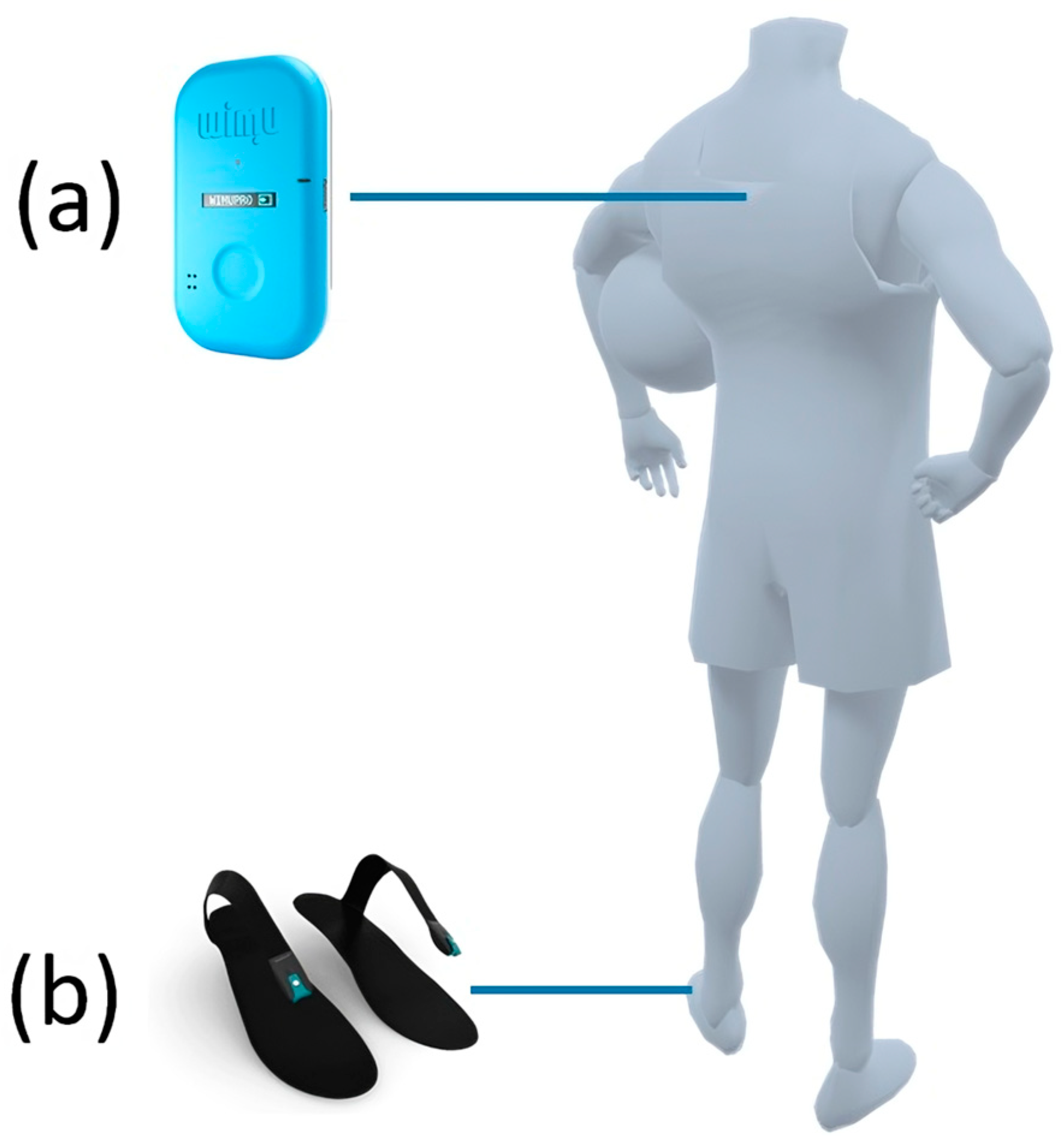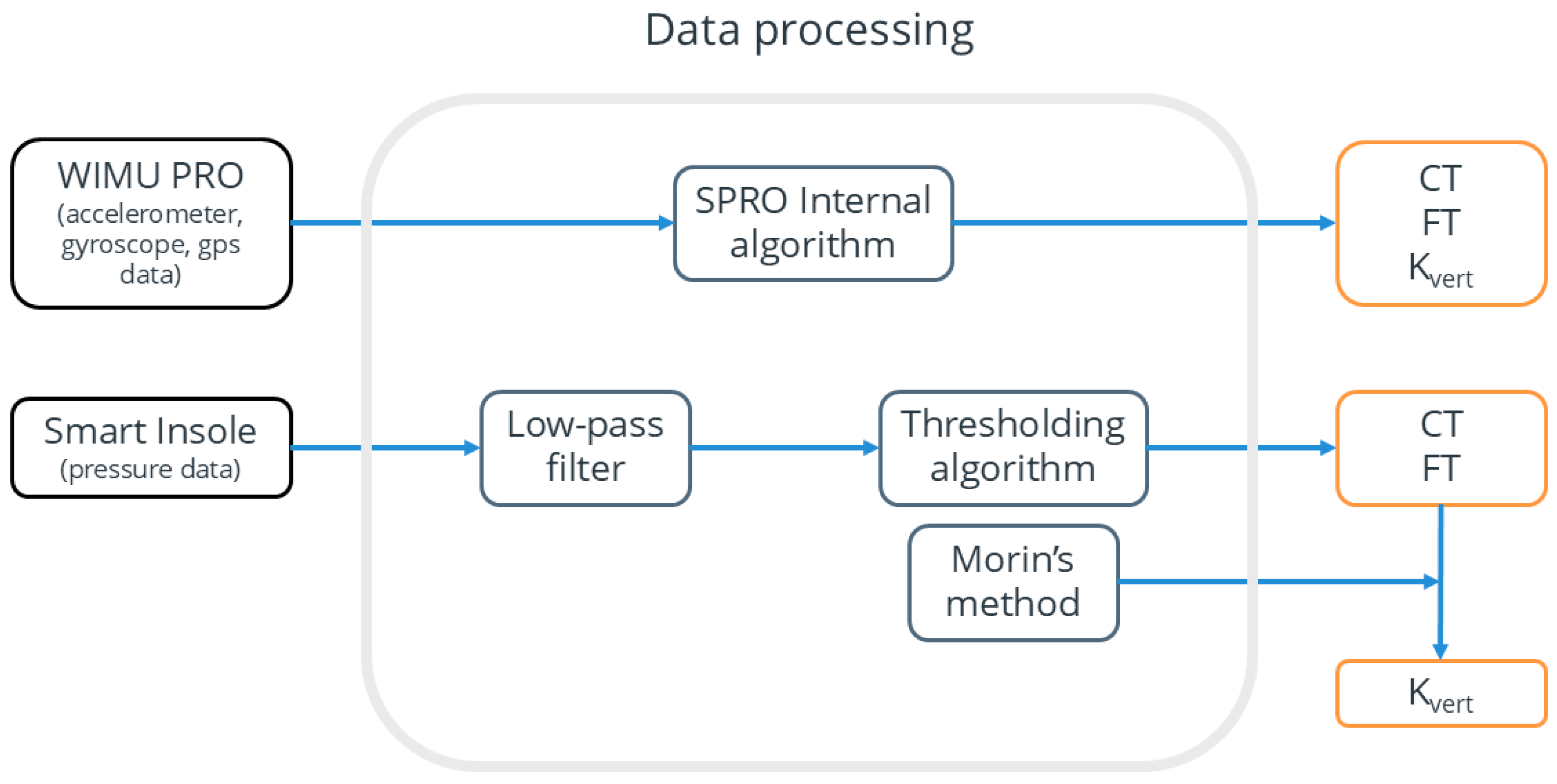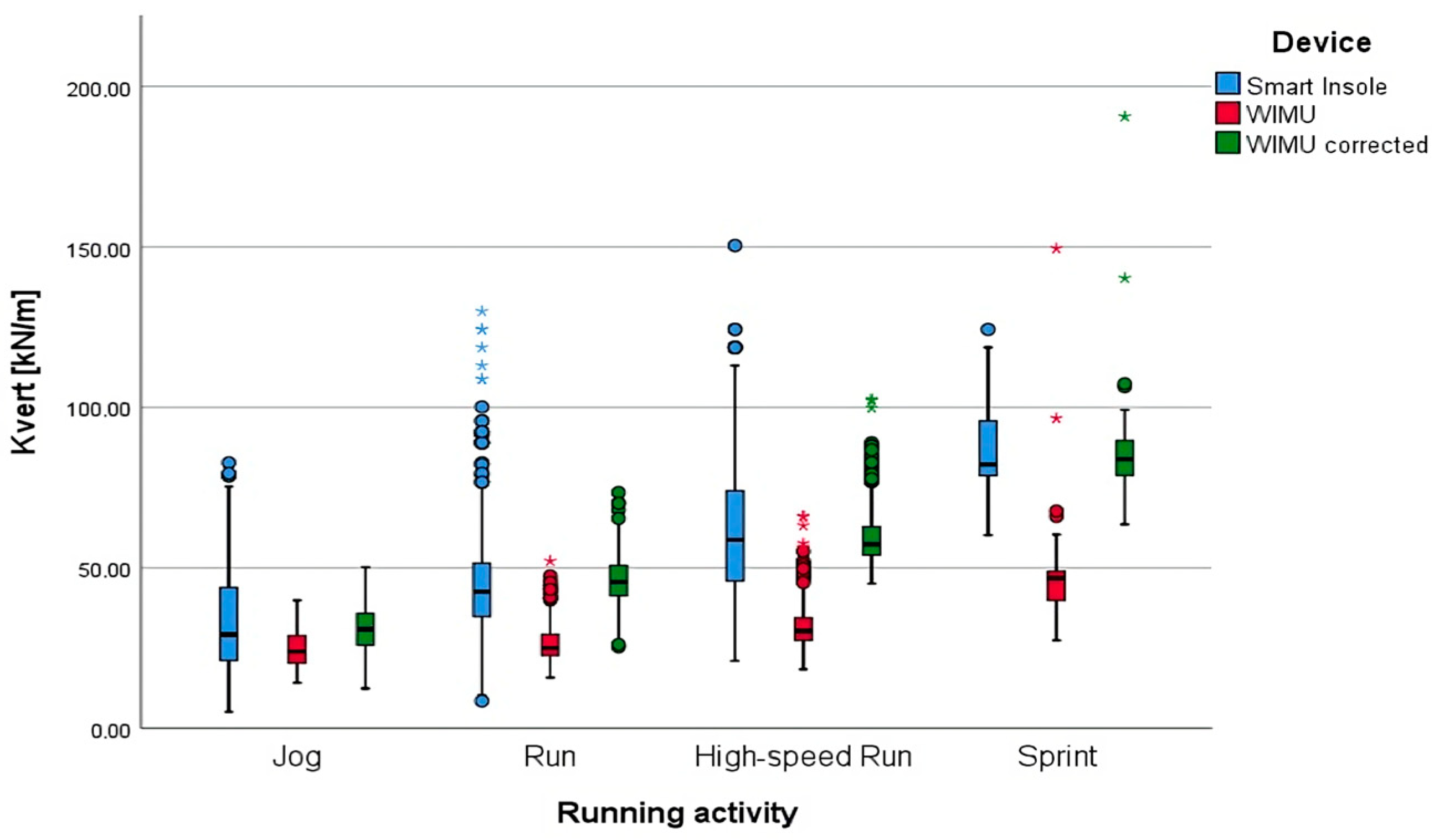Evaluation of WIMU Sensor Performance in Estimating Running Stride and Vertical Stiffness in Football Training Sessions: A Comparison with Smart Insoles
Abstract
:1. Introduction
2. Materials and Methods
2.1. Participants
2.2. Experimental Setup
2.3. Data Collection
2.4. Data Analysis
- WIMU PRO dataset: Contains timestamps, accelerometer data, GPS data, contact time (CT), flight time (FT), vertical stiffness (Kvert), and foot in contact with the ground.
- Smart insole dataset: Includes timestamps, ground reaction force (GRF) data from both feet, contact time (CT), flight time (FT), vertical stiffness (Kvert), and foot in contact with the ground.
2.5. Statistical Analysis
3. Results
3.1. Temporal Parameters Description
3.2. Statistical Results
3.2.1. Contact Time (CT)
3.2.2. Flight Time (FT)
3.2.3. Vertical Stiffness (Kvert)
3.3. Linear Regression Analysis
- C1: The coefficient for the WIMU-measured Kvert.
- C2 = 2.435 ± 0.167 : The coefficient for the velocity factor.
- C3: The intercept of the regression equation.
4. Discussion
5. Conclusions
Author Contributions
Funding
Institutional Review Board Statement
Informed Consent Statement
Data Availability Statement
Acknowledgments
Conflicts of Interest
References
- Hanley, B.; Tucker, C.B.; Gallagher, L.; Parelkar, P.; Thomas, L.; Crespo, R.; Price, R.J. Grizzlies and Gazelles: Duty Factor Is an Effective Measure for Categorizing Running Style in English Premier League Soccer Players. Front. Sports Act. Living 2022, 4, 939676. [Google Scholar] [CrossRef]
- Brechue, W.F.; Mayhew, J.L.; Piper, F.C. Characteristics of Sprint Performance in College Football Players. J. Strength Cond. Res. 2010, 24, 1169–1178. [Google Scholar] [CrossRef] [PubMed]
- Struzik, A. Measuring Leg Stiffness During Vertical Jumps: Theory and Methods; Springer International Publishing: Cham, Switzerland, 2019; ISBN 978-3-030-31793-5. [Google Scholar]
- Gill, N.; Preece, S.J.; Baker, R. Using the Spring-Mass Model for Running: Force-Length Curves and Foot-Strike Patterns. Gait Posture 2020, 80, 318–323. [Google Scholar] [CrossRef] [PubMed]
- Dalleau, G.; Belli, A.; Bourdin, M.; Lacour, J.-R. The Spring-Mass Model and the Energy Cost of Treadmill Running. Eur. J. Appl. Physiol. 1998, 77, 257–263. [Google Scholar] [CrossRef] [PubMed]
- Ferris, D.P.; Louie, M.; Farley, C.T. Running in the Real World: Adjusting Leg Stiffness for Different Surfaces. Proc. R. Soc. B Biol. Sci. 1998, 265, 989–994. [Google Scholar] [CrossRef] [PubMed]
- Butler, R.J.; Crowell, H.P.; Davis, I.M. Lower Extremity Stiffness: Implications for Performance and Injury. Clin. Biomech. 2003, 18, 511–517. [Google Scholar] [CrossRef]
- Maloney, S.J.; Fletcher, I.M. Lower Limb Stiffness Testing in Athletic Performance: A Critical Review. Sports Biomech. 2021, 20, 109–130. [Google Scholar] [CrossRef] [PubMed]
- Morin, J.B.; Dalleau, G.; Kyröläinen, H.; Jeannin, T.; Belli, A. A Simple Method for Measuring Stiffness during Running. J. Appl. Biomech. 2005, 21, 167–180. [Google Scholar] [CrossRef] [PubMed]
- Hunter, J.P.; Marshall, R.N.; McNair, P.J. Interaction of Step Length and Step Rate during Sprint Running. Med. Sci. Sports Exerc. 2004, 36, 261–271. [Google Scholar] [CrossRef] [PubMed]
- Ciacci, S.; Di Michele, R.; Merni, F. Kinematic Analysis of the Braking and Propulsion Phases during the Support Time in Sprint Running. Gait Posture 2010, 31, 209–212. [Google Scholar] [CrossRef] [PubMed]
- Coh, M.; Tomažin, K.; Stuhec, S. The Biomechanical Model of the Sprint Start and Block Acceleration. Facta Univ. Ser. Phys. Educ. Sport 2006, 4, 103. [Google Scholar]
- Ito, A.; Ishikawa, M.; Isolehto, J.; Komi, P.V. Changes in the Step Width, Step Length, and Step Frequency of the World’s Top Sprinters during the 100 Metres. New Stud. Athl. 2006, 21, 35–39. [Google Scholar]
- Riley, P.O.; Dicharry, J.; Franz, J.; Della Croce, U.; Wilder, R.P.; Kerrigan, D.C. A Kinematics and Kinetic Comparison of Overground and Treadmill Running. Med. Sci. Sports Exerc. 2008, 40, 1093–1100. [Google Scholar] [CrossRef] [PubMed]
- Camomilla, V.; Bergamini, E.; Fantozzi, S.; Vannozzi, G. Trends Supporting the In-Field Use of Wearable Inertial Sensors for Sport Performance Evaluation: A Systematic Review. Sensors 2018, 18, 873. [Google Scholar] [CrossRef] [PubMed]
- Preatoni, E.; Bergamini, E.; Fantozzi, S.; Giraud, L.I.; Orejel Bustos, A.S.; Vannozzi, G.; Camomilla, V. The Use of Wearable Sensors for Preventing, Assessing, and Informing Recovery from Sport-Related Musculoskeletal Injuries: A Systematic Scoping Review. Sensors 2022, 22, 3225. [Google Scholar] [CrossRef]
- Kelly, D.M.; Strudwick, A.J.; Atkinson, G.; Drust, B.; Gregson, W. Quantification of Training and Match-Load Distribution across a Season in Elite English Premier League Soccer Players. Sci. Med. Footb. 2020, 4, 59–67. [Google Scholar] [CrossRef]
- Lee, J.B.; Mellifont, R.B.; Burkett, B.J. The Use of a Single Inertial Sensor to Identify Stride, Step, and Stance Durations of Running Gait. J. Sci. Med. Sport 2010, 13, 270–273. [Google Scholar] [CrossRef] [PubMed]
- Bergamini, E.; Picerno, P.; Pillet, H.; Natta, F.; Thoreux, P.; Camomilla, V. Estimation of Temporal Parameters during Sprint Running Using a Trunk-Mounted Inertial Measurement Unit. J. Biomech. 2012, 45, 1123–1126. [Google Scholar] [CrossRef]
- Brughelli, M.; Cronin, J. A Review of Research on the Mechanical Stiffness in Running and Jumping: Methodology and Implications. Scand. J. Med. Sci. Sports 2008, 18, 417–426. [Google Scholar] [CrossRef]
- Buchheit, M.; Lacome, M.; Cholley, Y.; Simpson, B.M. Neuromuscular Responses to Conditioned Soccer Sessions Assessed via GPS-Embedded Accelerometers: Insights Into Tactical Periodization. Int. J. Sports Physiol. Perform. 2018, 13, 577–583. [Google Scholar] [CrossRef]
- Leduc, C.; Tee, J.; Lacome, M.; Weakley, J.; Cheradame, J.; Ramirez, C.; Jones, B. Convergent Validity, Reliability, and Sensitivity of a Running Test to Monitor Neuromuscular Fatigue. Int. J. Sports Physiol. Perform. 2020, 15, 1067–1073. [Google Scholar] [CrossRef] [PubMed]
- Renner, K.E.; Williams, D.S.B.; Queen, R.M. The Reliability and Validity of the Loadsol® under Various Walking and Running Conditions. Sensors 2019, 19, 265. [Google Scholar] [CrossRef]
- Cudejko, T.; Button, K.; Al-Amri, M. Wireless Pressure Insoles for Measuring Ground Reaction Forces and Trajectories of the Centre of Pressure during Functional Activities. Sci. Rep. 2023, 13, 14946. [Google Scholar] [CrossRef] [PubMed]
- Burns, G.T.; Deneweth Zendler, J.; Zernicke, R.F. Validation of a Wireless Shoe Insole for Ground Reaction Force Measurement. J. Sports Sci. 2019, 37, 1129–1138. [Google Scholar] [CrossRef] [PubMed]
- Scott, M.T.U.; Scott, T.J.; Kelly, V.G. The Validity and Reliability of Global Positioning Systems in Team Sport: A Brief Review. J. Strength Cond. Res. 2016, 30, 1470–1490. [Google Scholar] [CrossRef]
- Gómez-Carmona, C.D.; Pino-Ortega, J.; Sánchez-Ureña, B.; Ibáñez, S.J.; Rojas-Valverde, D. Accelerometry-Based External Load Indicators in Sport: Too Many Options, Same Practical Outcome? Int. J. Environ. Res. Public. Health 2019, 16, 5101. [Google Scholar] [CrossRef] [PubMed]
- Gómez-Carmona, C.D.; Bastida-Castillo, A.; García-Rubio, J.; Ibáñez, S.J.; Pino-Ortega, J. Static and Dynamic Reliability of WIMU PROTM Accelerometers According to Anatomical Placement. Proc. Inst. Mech. Eng. Part P J. Sports Eng. Technol. 2019, 233, 238–248. [Google Scholar] [CrossRef]
- Muñoz-López, A.; Granero-Gil, P.; Pino-Ortega, J.; De Hoyo, M. The Validity and Reliability of a 5-Hz GPS Device for Quantifying Athletes’ Sprints and Movement Demands Specific to Team Sports. J. Hum. Sport Exerc. 2017, 12, 156–166. [Google Scholar] [CrossRef]
- Maddison, R.; Ni Mhurchu, C. Global Positioning System: A New Opportunity in Physical Activity Measurement. Int. J. Behav. Nutr. Phys. Act. 2009, 6, 73. [Google Scholar] [CrossRef] [PubMed]
- Oliveira, R.; Brito, J.P.; Martins, A.; Mendes, B.; Marinho, D.A.; Ferraz, R.; Marques, M.C. In-Season Internal and External Training Load Quantification of an Elite European Soccer Team. PLoS ONE 2019, 14, e0209393. [Google Scholar] [CrossRef]
- Jennings, D.; Cormack, S.; Coutts, A.J.; Boyd, L.J.; Aughey, R.J. Variability of GPS Units for Measuring Distance in Team Sport Movements. Int. J. Sports Physiol. Perform. 2010, 5, 565–569. [Google Scholar] [CrossRef]
- Peebles, A.T.; Maguire, L.A.; Renner, K.E.; Queen, R.M. Validity and Repeatability of Single-Sensor Loadsol Insoles during Landing. Sensors 2018, 18, 4082. [Google Scholar] [CrossRef] [PubMed]
- Falbriard, M.; Meyer, F.; Mariani, B.; Millet, G.P.; Aminian, K. Accurate Estimation of Running Temporal Parameters Using Foot-Worn Inertial Sensors. Front. Physiol. 2018, 9, 610. [Google Scholar] [CrossRef]
- Morin, J.-B.; Jeannin, T.; Chevallier, B.; Belli, A. Spring-Mass Model Characteristics during Sprint Running: Correlation with Performance and Fatigue-Induced Changes. Int. J. Sports Med. 2006, 27, 158–165. [Google Scholar] [CrossRef]
- Paradisis, G.P.; Bissas, A.; Pappas, P.; Zacharogiannis, E.; Theodorou, A.; Girard, O. Sprint Mechanical Differences at Maximal Running Speed: Effects of Performance Level. J. Sports Sci. 2019, 37, 2026–2036. [Google Scholar] [CrossRef] [PubMed]
- Monte, A.; Nardello, F.; Pavei, G.; Moro, S.; Festa, L.; Tarperi, C.; Schena, F.; Zamparo, P. Mechanical Determinants of the Energy Cost of Running at the Half-Marathon Pace. J. Sports Med. Phys. Fitness 2020, 60, 198–205. [Google Scholar] [CrossRef] [PubMed]
- Zhou, Y.; Lu, Z.; Hu, J.; Hu, Y. Surrogate Modeling of High-Dimensional Problems via Data-Driven Polynomial Chaos Expansions and Sparse Partial Least Square. Comput. Methods Appl. Mech. Eng. 2020, 364, 112906. [Google Scholar] [CrossRef]
- Cawley, G.C.; Talbot, N.L.C. Efficient Approximate Leave-One-out Cross-Validation for Kernel Logistic Regression. Mach. Learn. 2008, 71, 243–264. [Google Scholar] [CrossRef]
- Farley, C.T.; González, O. Leg Stiffness and Stride Frequency in Human Running. J. Biomech. 1996, 29, 181–186. [Google Scholar] [CrossRef] [PubMed]
- Arampatzis, A.; Brüggemann, G.P.; Metzler, V. The Effect of Speed on Leg Stiffness and Joint Kinetics in Human Running. J. Biomech. 1999, 32, 1349–1353. [Google Scholar] [CrossRef]
- Hobara, H.; Inoue, K.; Gomi, K.; Sakamoto, M.; Muraoka, T.; Iso, S.; Kanosue, K. Continuous Change in Spring-Mass Characteristics during a 400 m Sprint. J. Sci. Med. Sport 2010, 13, 256–261. [Google Scholar] [CrossRef] [PubMed]
- García-Pinillos, F.; García-Ramos, A.; Ramírez-Campillo, R.; Latorre-Román, P.Á.; Roche-Seruendo, L.E. How Do Spatiotemporal Parameters and Lower-Body Stiffness Change with Increased Running Velocity? A Comparison Between Novice and Elite Level Runners. J. Hum. Kinet. 2019, 70, 25–38. [Google Scholar] [CrossRef] [PubMed]
- McMahon, T.A.; Cheng, G.C. The Mechanics of Running: How Does Stiffness Couple with Speed? J. Biomech. 1990, 23 (Suppl. S1), 65–78. [Google Scholar] [CrossRef] [PubMed]
- Beato, M.; Devereux, G.; Stiff, A. Validity and Reliability of Global Positioning System Units (STATSports Viper) for Measuring Distance and Peak Speed in Sports. J. Strength Cond. Res. 2018, 32, 2831. [Google Scholar] [CrossRef] [PubMed]
- Siegle, M.; Stevens, T.; Lames, M. Design of an Accuracy Study for Position Detection in Football. J. Sports Sci. 2013, 31, 166–172. [Google Scholar] [CrossRef] [PubMed]



| Temporal Parameter | Running Activities | Smart Insole | WIMU | ||
|---|---|---|---|---|---|
| Median | IQR | Median | IQR | ||
| Contact time [sec] | Jog | 0.19 | 0.07 | 0.24 | 0.05 |
| Run | 0.18 | 0.02 | 0.24 | 0.04 | |
| High-Speed Run | 0.16 | 0.03 | 0.22 | 0.03 | |
| Sprint | 0.13 | 0.02 | 0.18 | 0.04 | |
| Flight time [sec] | Jog | 0.11 | 0.05 | 0.08 | 0.04 |
| Run | 0.13 | 0.05 | 0.07 | 0.03 | |
| High-Speed Run | 0.12 | 0.03 | 0.06 | 0.01 | |
| Sprint | 0.11 | 0.02 | 0.05 | 0.03 | |
| Vertical stiffness [kN/m] | Jog | 31.3 | 27.1 | 23.8 | 8.5 |
| Run | 41.4 | 16.5 | 25 | 6.1 | |
| High-Speed Run | 55.1 | 29.6 | 30.3 | 6.5 | |
| Sprint | 82.2 | 28.7 | 45.6 | 12.7 | |
| Temporal Parameter | Running activities | Wilcoxon p-Value | ICC | ICC CI95% min | ICC CI95% max | Pearson Coeff. | Pearson p-Value | Cronbach’s Alpha |
|---|---|---|---|---|---|---|---|---|
| Contact time [sec] | Jog | <0.001 * | 0.542 | 0.39 | 0.67 | 0.600 | <0.001 * | 0.703 |
| Run | <0.001 * | 0.313 | 0.25 | 0.37 | 0.317 | <0.001 * | 0.477 | |
| High-Speed Run | <0.001 * | 0.478 | 0.41 | 0.54 | 0.512 | <0.001 * | 0.647 | |
| Sprint | <0.001 * | 0.208 | −0.08 | 0.46 | 0.280 | 0.054 | 0.345 | |
| Flight time [sec] | Jog | <0.001 * | 0.321 | 0.13 | 0.49 | 0.324 | 0.001 * | 0.486 |
| Run | <0.001 * | 0.383 | 0.33 | 0.44 | 0.386 | <0.001 * | 0.554 | |
| High-Speed Run | <0.001 * | 0.270 | 0.19 | 0.35 | 0.274 | <0.001 * | 0.426 | |
| Sprint | <0.001 * | 0.205 | −0.08 | 0.46 | 0.309 | 0.033 * | 0.341 | |
| Vertical stiffness [kN/m] | Jog | <0.001 * | 0.386 | 0.21 | 0.54 | 0.690 | <0.001 * | 0.557 |
| Run | <0.001 * | 0.267 | 0.2 | 0.33 | 0.458 | <0.001 * | 0.421 | |
| High-Speed Run | <0.001 * | 0.377 | 0.3 | 0.45 | 0.600 | <0.001 * | 0.548 | |
| Sprint | <0.001 * | 0.161 | −0.13 | 0.42 | 0.177 | 0.228 | 0.278 |
| Statistics | Mean | Standard Deviation | Min | Max |
|---|---|---|---|---|
| R-squared | 0.451 | 0.037 | 0.359 | 0.496 |
| F-statistic | 582.084 | 78.082 | 391.822 | 687.140 |
| F-statistic p-value | <0.001 * | <0.0001 * | <0.0001 * | <0.0001 * |
| RMSE | 15.24 | 0.80 | 13.24 | 15.90 |
| C1 p-value | <0.001 * | <0.0001 * | <0.0001 * | <0.0001 * |
| C2 p-value | <0.001 * | <0.0001 * | <0.0001 * | <0.0001 * |
| C3 p-value | <0.001 * | <0.0001 * | <0.0001 * | <0.0001 * |
| SE C1 | 0.061 | 0.006 | 0.055 | 0.076 |
| SE C2 | 0.149 | 0.005 | 0.138 | 0.155 |
| SE C3 | 2.42 | 0.07 | 2.30 | 2.57 |
| Temporal Parameter | Running Activities | Wilcoxon p-Value |
|---|---|---|
| Vertical stiffness [kN/m] | Jog | 0.399 |
| Run | <0.001 * | |
| High-Speed Run | 0.037 * | |
| Sprint | 0.857 |
Disclaimer/Publisher’s Note: The statements, opinions and data contained in all publications are solely those of the individual author(s) and contributor(s) and not of MDPI and/or the editor(s). MDPI and/or the editor(s) disclaim responsibility for any injury to people or property resulting from any ideas, methods, instructions or products referred to in the content. |
© 2024 by the authors. Licensee MDPI, Basel, Switzerland. This article is an open access article distributed under the terms and conditions of the Creative Commons Attribution (CC BY) license (https://creativecommons.org/licenses/by/4.0/).
Share and Cite
Pinelli, S.; Mandorino, M.; Lacome, M.; Fantozzi, S. Evaluation of WIMU Sensor Performance in Estimating Running Stride and Vertical Stiffness in Football Training Sessions: A Comparison with Smart Insoles. Sensors 2024, 24, 8087. https://doi.org/10.3390/s24248087
Pinelli S, Mandorino M, Lacome M, Fantozzi S. Evaluation of WIMU Sensor Performance in Estimating Running Stride and Vertical Stiffness in Football Training Sessions: A Comparison with Smart Insoles. Sensors. 2024; 24(24):8087. https://doi.org/10.3390/s24248087
Chicago/Turabian StylePinelli, Salvatore, Mauro Mandorino, Mathieu Lacome, and Silvia Fantozzi. 2024. "Evaluation of WIMU Sensor Performance in Estimating Running Stride and Vertical Stiffness in Football Training Sessions: A Comparison with Smart Insoles" Sensors 24, no. 24: 8087. https://doi.org/10.3390/s24248087
APA StylePinelli, S., Mandorino, M., Lacome, M., & Fantozzi, S. (2024). Evaluation of WIMU Sensor Performance in Estimating Running Stride and Vertical Stiffness in Football Training Sessions: A Comparison with Smart Insoles. Sensors, 24(24), 8087. https://doi.org/10.3390/s24248087








